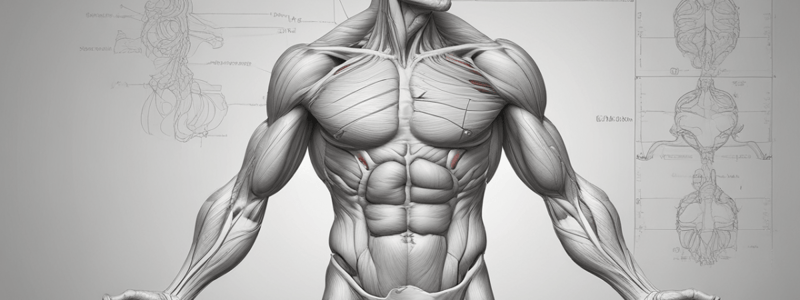Podcast
Questions and Answers
What is the correct order of muscle structure from smallest to largest?
What is the correct order of muscle structure from smallest to largest?
- Myofilaments, muscle fiber, myofibril, fascicle, muscle
- Myofilaments, myofibril, muscle fiber, fascicle, muscle (correct)
- Muscle, fascicle, muscle fiber, myofibril, myofilaments
- Myofibril, myofilaments, muscle fiber, fascicle, muscle
What is the main function of the origin of a muscle?
What is the main function of the origin of a muscle?
- To remain stationary and provide anchor points (correct)
- To provide blood supply to the muscle
- To move the bone it is attached to
- To stretch and flex the muscle
What type of muscle is responsible for involuntary actions in the gastrointestional tract?
What type of muscle is responsible for involuntary actions in the gastrointestional tract?
- Voluntary muscle
- Skeletal muscle
- Cardiac muscle
- Smooth muscle (correct)
What is the main function of the nervous system?
What is the main function of the nervous system?
What type of joint allows for movement in multiple directions?
What type of joint allows for movement in multiple directions?
What is an example of a cartilaginous joint?
What is an example of a cartilaginous joint?
What is the movement allowed by a condyloid joint?
What is the movement allowed by a condyloid joint?
What is an example of a hinge joint?
What is an example of a hinge joint?
What is an example of negative feedback in homeostasis?
What is an example of negative feedback in homeostasis?
What is the term for the ability of the body to maintain a stable internal environment?
What is the term for the ability of the body to maintain a stable internal environment?
What is the term for the process by which an organism maintains internal stability while adjusting to external conditions?
What is the term for the process by which an organism maintains internal stability while adjusting to external conditions?
Which type of joint allows for rotary movement?
Which type of joint allows for rotary movement?
What is the total number of bones in the adult human skeletal system?
What is the total number of bones in the adult human skeletal system?
Which type of bone is exemplified by the humorous bone?
Which type of bone is exemplified by the humorous bone?
Which body system is responsible for producing blood cells and releasing and storing minerals and fat?
Which body system is responsible for producing blood cells and releasing and storing minerals and fat?
What is the term for the joint that allows for limited movement between two smooth surfaces?
What is the term for the joint that allows for limited movement between two smooth surfaces?
Which type of joint is exemplified by the joint between the shoulder and the humerus?
Which type of joint is exemplified by the joint between the shoulder and the humerus?
How many body systems are mentioned in the text?
How many body systems are mentioned in the text?
Which type of bone is exemplified by the sternum?
Which type of bone is exemplified by the sternum?
Flashcards are hidden until you start studying
Study Notes
Structure of a Muscle
- Smallest to largest: myofilaments, myofibril, muscle fiber, fascicle, muscle
- Muscle fibers are protected by:
- Epimysium (connective tissue surrounding the entire muscle)
- Perimysium (connective tissue connecting each bundle of muscle fibers)
- Endomysium (innermost sheath surrounding individual muscle fibers)
Origin and Insertion
- Origin: does not move
- Insertion: movement occurs
- Example: trapezius origin (down the spine), insertion (around the scapula and clavicle)
Muscular System
- Skeletal muscles:
- Function: movement and posture
- Example: voluntary actions
- Cardiac muscles:
- Function: contraction, pumping of blood, helps heart
- Smooth muscles:
- Function: involuntary actions
- Examples: gastrointestinal, urinary, and respiratory
Nervous System
- Parts: brain, spinal cord, nerves
- Function: motor and sensory functions (controls everything you do)
Joints
Synovial Joints
- Types:
- Ball and socket
- Gliding
- Pivot
- Saddle
- Hinge
- Conyloid
- Movement: varying degrees of movement
Cartilaginous Joints
- Movement: slight movement
- Examples: pubic symphysis, synchondrosis (part of the rib that connects to the sternum)
Condyloid Joints
- Examples: knuckles
- Movement: up, down, side to side
Hinge Joints
- Examples: elbow, knee
- Movement: back and forth (e.g., hinge on a door)
Homeostasis
- Definition: self-regulating process maintaining internal stability while adjusting to external conditions
- Examples:
- Negative feedback: heart pumping faster for oxygen during exercise
- Positive feedback: (not provided)
Saddle Joints
- Examples: thumb, shoulders, ear
- Movement: up, back, down, and forth
Pivot Joints
- Examples:
- Joint between the atlas and the skull (allows head to turn from side to side)
- Joint between the radius and ulna (twisting movement of forearm bones, e.g., unscrewing a jar lid)
Ball and Socket Joints
- Examples: shoulder and hips
- Movement: backwards, forward, sideways, and rotating
Body Systems
- Skeletal system
- Nervous system
- Lymphatic system
- Muscular system
- Cardiovascular system (capillaries)
- Reproductive system
- Urinary system
- Integumentary system
- Endocrine system
- Digestive system
- Respiratory system
Gliding Joints
- Examples: ankles, wrists, spine
- Movement: limited movement (smooth surfaces gliding over each other)
Skeletal System
- Parts: 206 bones total
- Function:
- Supports the body
- Facilitates movement
- Protects organs
- Produces blood cells
- Releases and stores minerals and fat
- Bone shapes:
- Long bones (humerus)
- Flat bones (sternum)
- Short bones (metacarpals)
- Sesamoid bones (thoracic vertebrae)
- Axial bones (skull, vertebrae, column, rib cage, hyoid bone)
- Appendicular bones (arms, shoulders, hands, legs, pelvic girdle)
Studying That Suits You
Use AI to generate personalized quizzes and flashcards to suit your learning preferences.




